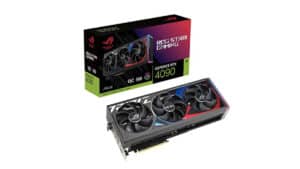Best GPU for 1440p 240Hz in 2024 – our top graphics cards

The best graphics card (GPU) for 1440p 240Hz is an important decision for anyone looking to get the most out of their gaming or streaming experience. With so many different options available, choosing the right one can be difficult. However, there are certain things to consider when selecting a GPU that will provide maximal performance while still offering great value.
Let’s keep in mind that 240Hz will require you to run games at 240 FPS. And doing that across all titles on a 1440p resolution is hard. You’ll need not only a great GPU but also a good CPU to battle that fight. So, expect the best-of-the-best components to build that PC.
Products at a Glance
How we picked the best GPU for 1440p 240Hz
We have evaluated each GPU on multiple factors such as performance, features, power consumption, and even price. We took into account how well each GPU can handle games at high frame rates and resolutions, as well as how much value it brings to its price point. On top of this, we endevour to test all the latest GPUs through a series of benchmarks, from AAA games such as Cyberpunk 2077 to Synthetic Benchmarks like Cinebench and Fire Strike Ultra. Once we’ve done all of this, we then curate the below list. In this case, we’ve hand-picked four GPUs that are perfect for 1440p, 240Hz gaming setups.
Product Reviews
- The best performance on the market - with a massive 24GB of GDDR6X VRAM
- Strong ray tracing as expected for a card with 16,384 CUDA cores
- DLSS 3.0 supported, which is a step up from the previous iteration
- Best-in-class performance in our stress tests
- Expensive but this is expected for the top-end card
- Power-hungry with a 450W TDP - meaning you'll need an expensive PSU
- RTX 4080 Super is a cheaper alternative for those wanting near 4090 levels of performance
- May be overkill for those wanting just 1440p
Achieving more than 200+ FPS constantly across every title is not an easy job. But thanks to the RTX 4090’s 24 GB GDDR6X, 384-bit memory bus, 1,008 GB/s bandwidth, and 2520 MHz boost clock, Nvidia’s flagship GPU reigns supreme. In our testing, where we switch off things like DLSS to run the card through native, raw tests, we saw the 4090 tear through the likes of Cyberpunk 2077, Doom Eternal and Assassin’s Creed: Mirage when all settings were set to Ultra.
To give you a better idea, the card managed 74 FPS in Cyberpunk without DLSS enabled and settings maxed out. With ray tracing enabled, it managed 43 frames, but remember, in this instance you would usually rely on DLSS 3.0. The full RTX 4090 benchmarking data can be seen as part of our RTX 4090 review. Now for the downsides. The 4090 is a power-hungry and expensive GPU. You’ll need to get a stronger PSU and a proper CPU to match the graphics card speed and avoid bottlenecking. So bear in mind that the investment will be high. An alternative to the RTX 4090 could be the 4080 Super, which we detail below.
- Great price and can go toe-to-toe with more expensive Nvidia equivalents
- Excels in 1440p with over 100fps in the majority of cases in our testing
- 24 GB GDDR6 memory gives you plenty of room for top-end 1440p and beyond
- Ray tracing performance is not as good as Nvidia cards
- Far from the cheapest RDNA 3 card
Just as Nvidia would need its best unit to achieve this performance, AMD also needs the 7900 XTX flagship unit to get 200+ FPS in a 1440p panel. The problem with this resolution and refresh rate is that it requires a lot of memory from the GPU. Also, you’ll need a transfer speed so fast that not all of them can handle it. Luckily that’s not the case for the 7900.
The RX 7900 XTX is a top-of-the-notch AMD GPU and we scored it as such in our RX 7900 XTX review. It features 24 GB GDDR6 memory, 6144 cores with 57,700 million transistors, a 384-bit memory bus, and 960.00 GB/s of bandwidth. If this is added up to the 2499 MHz of boosted clock speed, and the 96 MB of specialized L3 cache, the 7900 XTX will reach the expected FPS in the vast majority of games. When we tested this hypothesis, we found the card ‘had absolutely no problems’ hitting 4K 60 native and beyond. At 1440p, the card shined even more, hitting 137 FPS on Cyberpunk 2077 (Ultra) without FSR enabled. A true AMD alternative to the RTX 4080 Super, and a cheaper option for those wanting to mazimise performance on a tighter budget.
- Superior ray tracing and just about outshines the original RTX 4080
- Great DLSS 3.0 perforrmance across a number of games
- Performs very strongly when tested for native 1440p and 4K
- Expensive so those on a tighter budget may want to consider the Rx 7900 XTX
- Not quite RTX 4090 levels of performance, so may be worth spending a little extra if that is important to you
- Not a huge leap over the original RTX 4080
The RTX 4080 Super is easily one of the best cards around, with the team here scoring it 4/5 in our 4080 Super review. The 4080 Super takes the original RTX 4080‘s Ada Lovelace architecture, which permits 16 GB of GDDR6X video memory then adds a few tweaks. CUDA cores are up to 10,240 from the first iteration’s 9,728 (a 5% upgrade). There’s also now 320 texture mapping units (TMUs) as opposed to 304. This means you’re getting around a 2-5% performance gain compard to original card. Did we mention it works out cheaper, too? Benchmarking performance is as expected… stunning. In Assassin’s Creed: Mirage and Avatar: Frontiers of Pandora, the card was able to deliver 139fps and 119fps in 1440p and leading figures of 95fps apiece in 4K respectively. Again, this is without DLSS 3.0 enabled. A true beast of a card and a fantastic alternative to the RTX 4090.
- Arguably the best pound-for-pound card on this list
- Strong performance thanks to 20 GB GDDR6 VRAM and a boost clock speed of 2394 MHz
- Largely excels across the board in 1440p and 4K
- Ray tracing performance, again, is not up to scratch
- Slower GDDR6 memory and is overshadowed by newer, stronger Nvidia GPUs
Finally, we have the RX 7900 XT. This is the dimmed-down version of the XTX. It features less memory, lower clock speed, and less cache. But don’t let that fool you, this GPU will deliver even better performance than the original 4080 in some cases. In our testing, we concluded that the AMD Radeon RX 7900 XT ‘largely excels’ across the board in 1440p and 4K, achieving 60fps or higher natively in the majority of tests run.
The 7900 XT features a 20 GB GDDR6 VRAM, a boost clock speed of 2394 MHz, and an L3 cache of 80 MB. This gives the GPU more than enough power to beat the 200+ FPS barrier at 1440p gaming. Besides, AMD’s approach to gaming performances through Infinity cache helps a lot. If you’re looking to play in a 1440p 240Hz panel, this one would be the best option to save some bucks because it’s also the cheaper GPU on the list.
Features and considerations
For gamers looking to take their gaming experience to the next level, a GPU for 1440p 240Hz gaming is essential. GPUs are responsible for delivering stunning visuals with minimal input lag, making them an integral part of any serious gaming setup. But with so many different products on the market, it can be difficult to know which GPU is best suited for your specific needs.
When selecting a GPU for 1440p 240Hz gaming, there are several important features and considerations that must be taken into account.
First and foremost, you’ll want to make sure that the GPU has enough power to handle frame rates up to 240fps without any stuttering or tearing. You’ll also want to consider the memory capacity of the video card and its cooling system, as well as compatibility with other components in your machine – like your motherboard.
Our Verdict
Each and every one of these cards will suffice to play AAA and competitive games at 240 FPS in a 1440p panel. However, in this case, paying more will give you more performance.
Although that’s not regularly the rule, we can avoid the fact that ray tracing plays a strong role in modern games. All games are being built under this technology and Nvidia has the proper environment to show those advances. For that reason, the RTX 4090 is the best GPU for 1440p 240Hz gaming. For those on a budget, consider the 7900 XT, which offers plenty of performance with very little compromise, especially at 1440p. If you’re looking for more graphics cards options, check out our best GPUs, which we keep up to date with the latest products from Nvidia and AMD.








